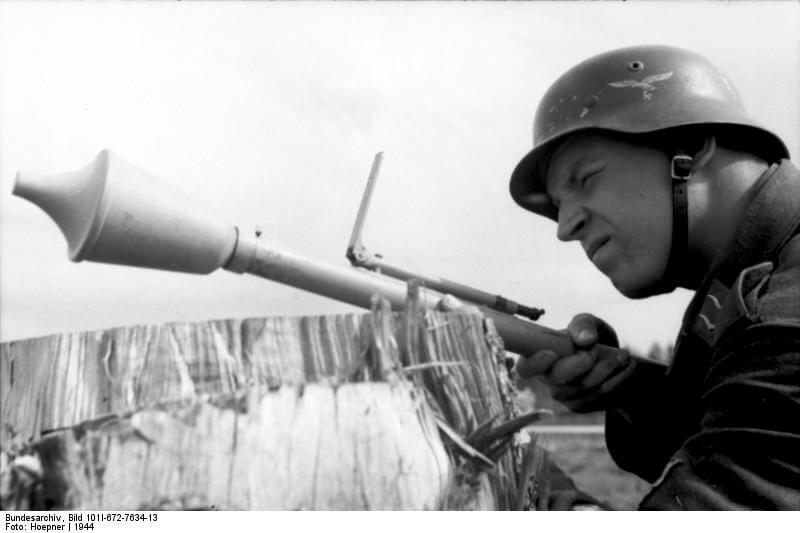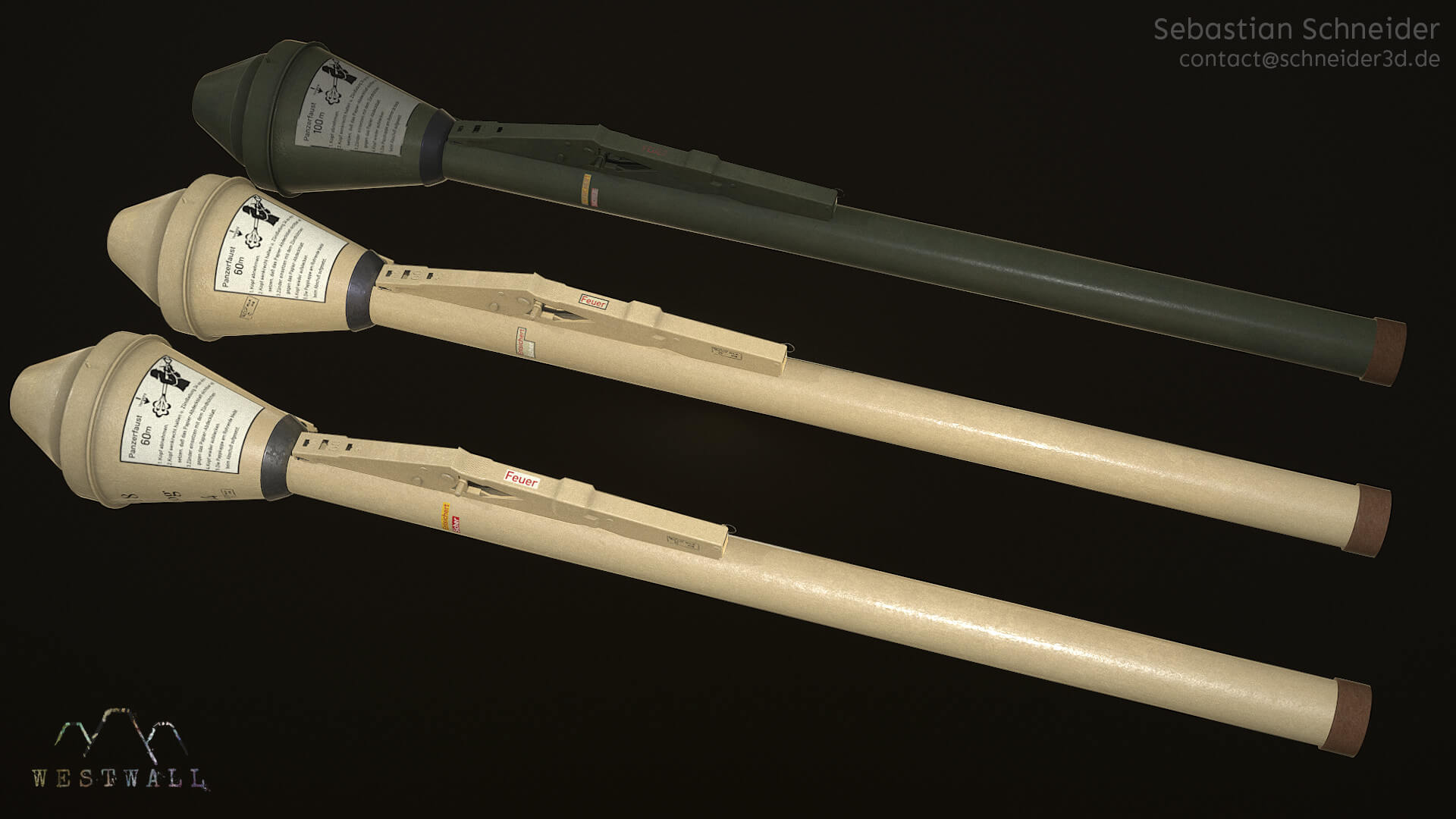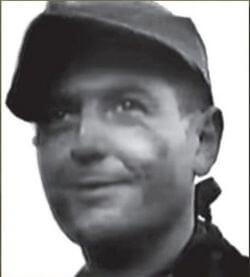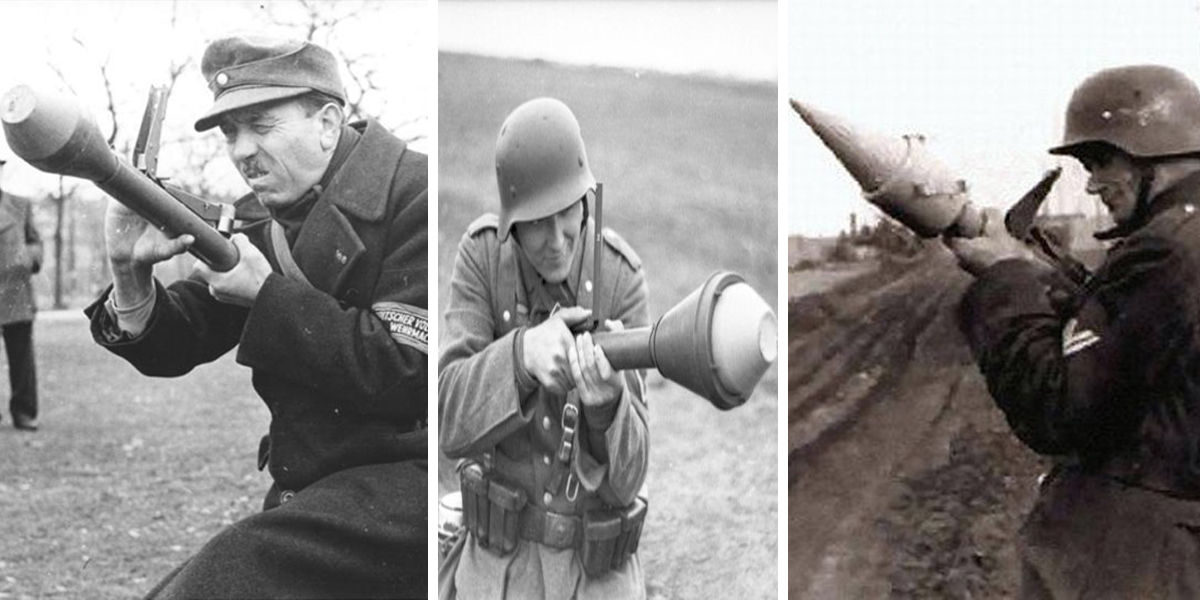The Panzerfaust(literally Tank fist) represented one of the most iconic and prolific German infantry anti-tank weapons of WW2. It gave the possibility for the Wehrmacht troops to deal with the assault of heavy tanks much more efficiently.
It seems that today, in some history books about World War II, it is common to describe the Panzerfaust as low quality and an inefficient weapon that was given to Volkssturm and Hitlerjugend units in the last days of World War 2.
However, this is far from the truth. It was an extremely effective anti-tank weapon and was widely used by the Wehrmacht on both the Eastern and Western fronts.
Panzerfaust: Definition/basics

The Panzerfaust was a single shot, recoilless anti-tank weapon, developed by Nazi Germany in late 1942 and first used by the Wehrmacht troops in 1943 against the Soviet tanks.
The main advantages of this weapon: in terms of production it was cheap; could be quickly produced on a large scale; on the battlefield, it was simple to use; it had very good accuracy and it could be easily transported.
These traits made the Panzerfaust a real tank killer and it provided the German infantry the necessary means to knock out heavy tanks on the battlefield.
Panzerfaust components

The main components of a Panzerfaust were: the projectile (German Kopf); the tube (Rohr) on which the iron sight and the trigger (Abzug) are located, and not in the last propellant charge.
Of course, other elements were added to these main components on the later variants. The iron sights and trigger mechanisms also evolved from the initial Panzerfaust 30 to the later Panzerfaust 150.
To prevent accidental launches, there was also a safety slide was attached to the trigger.
The projectile (Kopf), blunt/ later conical shape, was, in turn, made up of a frontal part (Kappe, the blunt nose cap), the back part called (Geschoßkörper), and a tube tail (Geschoßzapfen).
Inside this projectile was an explosive charge called Pentol, which weighed 800 g, by comparison, the American bazooka had an explosive charge of only 220 g (80 oz).
The initial length of the first Panzerfaust 30 models(Klein and Gross) launcher tubes(Rohr) was about 985 mm and 1045 mm respectively.
The standard overall length of the launcher tube for the Panzerfaust remained at 1045 mm even for the later variants in the war. The Rohr like the warhead(Kopf) was made of steel.
The launcher tube caliber increased from 33 mm to 44 mm with the development of later variants.
The explosive used for the propellant charge was black powder. The initial weight of the propellant charge was only 53.5 grams for the Panzerfaust 30 Klein models. When the Panzerfaust 60 was developed the weight of the propellant charge increased to 134 grams, more than double from the previous versions.
When the Panzerfaust 100 was introduced, the Germans added a second explosive charge in the back of the tube. The idea was that the detonation of the back charge will cause the explosion of the frontal one, and thus the speed and range of the projectile would increase significantly.
Once fired the back-blast from the propellant was so powerful that it could go to almost 2 meters from the Panzerfaust operator and was very dangerous for anyone nearby.
Panzerfaust variants:
| Panzerfaust 30(klein) | Panzerfaust 30 (gross | Panzerfaust 60 | Panzerfaust 100 | Panzerfaust 150 | |
| Weight | 3.2kg | 5.22kg | 6.8kg | 6.8kg | 7kg |
| Projectile weight | – | – | – | – | – |
| Warhead weight | 1.3kg | 2.9kg | 2.9kg | 2.9kg | unknown |
| Propellant | 53.5g | 95g | 134g | 2×95g=190g | 2×95g=190g |
| Overall length | 985mm | 1,045mm | 1,045mm | 1,045mm | 1,045mm |
| Warhead diameter | 95mm | 140mm | 140mm | 140mm | 105mm |
| Launch tube diameter | 33mm | 44mm | 44mm | 44mm | 44mm |
| Effective range | 30m (33yd) | 30m (33yd) | 60m (66yd) | 100m (109yd) | 150m |
| Initial velocity | 28m/sec | 30m/sec | 48m/sec | 62m/sec | 82m/sec |
| Penetration | 140mm | 200mm | 200mm | 200mm | 220mm |
The development and supervision of the first Panzerfaust models began in November 1942, the entire project was coordinated by a team from HASAG’s(Hugo Schneider AG) research department from Leipzig, led by Dr. Heinrich Langweiler.
Dr. Heinrich Langweiler was assisted in this project by 10 scientists and 250 technicians and workers.
By July 1943, 3000 models of Panzerfaust 30(Klein) and Panzerfaust 30(gross) were ordered by the German Army from the Eastern front, and after the results proved to be good, in October 1943 the weapons entered into mass production.
Panzerfaust 30 Klein (“small”) or Faustpatrone
Initially called FP 1, Panzerfaust Klein had a 95 mm warhead(the smallest of all Panzefaust models) and a launch tube of 33 mm diameter. The first Panzerfaust model was also the lightest in terms of weight(3.2 kg/7 lb).
The effective firing range was only 30 meters. Once fired the projectile could reach the speed of 28 m/sec. Unlike the other models, the penetration capability of this weapon was limited to 140 mm of armor.
The mass production of Panzerfaust 30 Klein stopped in April 1944, from this point the German industry focused on more advanced variants.
Panzerfaust 30 Gross(large)
Officially designed FP 2, it represented an improved version of Panzerfaust 30 Klein. Initially, both Panzerfaust models, Klein and gross, were mass-produced and sent to the battlefield at the same time. The development of Panzerfaust 30 gross began in January 1943.
This version of the weapon had a 140 mm blunt warhead. For launching it used a 44 mm diameter tube. Common components with the previous variant were represented by the iron sight and firing mechanism.
Because the dimensions of the warhead and the propellant charge were increased, the armor penetration capability was increased to 200 mm.
On the battlefield, according to military reports, the warhead proved to be very effective against T-34s, KV-1s, Shermans, Churchills, and Matildas.
Although it didn’t manage to penetrate the frontal armor, it had an impressive success against the side and rear armor of any vehicle.
The effectiveness of this weapon was limited like in the case of Panzerfaust Klein by the small firing range of only 30 meters.
Panzerfaust 60
The earlier models of Panzerfaust proved their limitations, especially in terms of effective range. Panzerfaust 60 would represent the solution for the firing range issue.
The development of this variant started in the middle of 1943 and was completed in early 1944. The larger propellant charge(134 g) meant that the effective range was increased to 60 meters and the projectile velocity was increased by a third, compared to previous models.
The probability to hit a target at 60 meters was between 50-70%.
New features of this weapon were represented by the firing mechanism and iron sight.
Panzerfaust 100
The development of Panzerfaust 100 started in the summer of 1944 and ended in September, the same year. The mass production of this weapon began in October 1944.
The main difference from the previous models was that the projectile would be launched with the help of 2 explosive charges of 95g each, previous versions used only 1 explosive charge.
The idea was that the detonation of the first charge from the tube will cause the explosion of the second. This ingenious feature, allowed the projectile to reach the incredible speed of 10 meters per second.
The iron sight was calibrated for the following ranges: 50, 100, and 150.
To avoid accidental detonations, the German scientists also fitted the Panzerfaust 100 with a new impact fuze called e FPZ 8003. This allowed the weapon to be transported in an armed state.
Panzerfaust 150
The development of the last Panzerfaust variant that went into serial production, Panzerfaust 150, began in October 1944. The goal was to enter mass production in January-February 1945.
The army ordered approximately 100.000 Panzerfaust 150 in the spring of 1945.
It is still unclear, how many Panzerfaust 150 were produced or if any of them reached the frontlines in the last weeks of the war.
Related to whether or not the Panzerfaust 150 was a weapon that could be reloaded. Sources and weapons experts give conflicting information.
There is also the middle variant, the first Panzerfaust 150 launchers were probably designed as a single shot, while the late variants were designed as reloadable.
The hypothesis that the Panzerfaust 150 was a reloadable rocket launcher is supported by the raw material crisis that the Third Reich was going through in 1945.
According to Zaloga, the Wehrmacht offered in 1945 a bonus of 3 cigarettes for every Panzerfaust 60-100 tube that was returned to the factory for repurposing.
The main difference between the Panzerfaust 150 and the earlier variants of this weapon, was given by the shape of the warhead. The projectile had a cylindrical shape, and conical nose, similar to the modern RPG-2.
The iron sight of the weapon could be calibrated for the following distances: 50, 100, 150, and 200 meters.
According to some sources, because of the new shape of the projectile, the penetration capability of the Pzf 150 was about 340 mm or armor. Only at the end of the war, after officials from HASAG were interrogated, it was discovered that Panzerfaust 150 could only penetrate 200 mm of armor, but it required a smaller amount of explosives to do so.
Panzerfaust 250
The latest Panzerfaust variant, Panzerfaust 250, didn’t get past the drawing board. When fully developed, the new Panzerfaust, unlike its predecessors, the launcher could’ve been reloaded.
The intention was to replace the Panzershreck. Another change was represented by the trigger system, the new weapon would’ve featured a pistol grip.
The projectile was similar to the one used for the Panzerfaust 150 and would’ve been propelled to the target by explosives located in both the tube and the warhead itself.
Serial production, according to Steven Zaloga, was scheduled to begin in August 1945.
Panzerfaust: Historical context
Gradually tanks began to appear with armor thick enough to resist typical 37mm antitank guns. This became very apparent during the Battle of France in May–June 1940 with the debut of more heavily armored tank types such as the French and British infantry tanks that had armor 40mm thick or more.
Yet the campaign was over so quickly that the Wehrmacht considered that further development of better anti-tank weapons was not necessary. A new 5cm antitank gun, the PaK 38, was slowly entering service, but the Wehrmacht continued to rely on the much less powerful 3.7cm PaK 36 anti-tank gun.
In the summer of 1941 during Operation Barbarossa, the invasion of the Soviet Union, the Wehrmacht was confronted by even more heavily armored Soviet tanks, the T‑34 medium tank, and the KV heavy tank.
In most circumstances, these tanks were almost invulnerable to both the obsolete PAK 36 –nicknamed “the door knocker” since all it could do was to announce its presence to its Soviet opponents – and the new PAK 38.
Soviet tanks literally drove over German PaK 36 with impunity. While new German antitank guns emerged in 1942, such as the 7.5cm PaK 40, the German infantry endured more than a year of combat during which they had few weapons capable of dealing with the Soviet armor threat.
Until the new and more powerful antitank guns appeared, the German infantry had to rely on weapons of desperation.
Owing to their size and weight, these large antitank guns were available in very limited numbers. In a 1943 German infantry division, for example, there were only 12 7.5cm antitank guns, guarding a front many miles wide.
When one antitank gun faced one tank, it was an even match. When one antitank gun faced a platoon of five tanks, however, it might knock out one or two tanks before it was destroyed by the other tanks.
The massive use of medium and heavy tanks by the Red Army forced the German command to urgently invest in the development of new anti-tank weapons for infantry units.
The idea behind the Panzerfaust was not bad. The German military industry has not been able to produce enough anti-tank guns to keep up with the mass production of enemy factories.
Panzerfaust: Production
Manufacture of the Panzerfaust increased from the initial order of 40,000 per month in October 1943 to 250,000 in August 1944. On September 16, 1944, Hitler ordered a special program to increase production to 1 million per month by November 1944 as a matter of “absolute priority over all others.”
Production first exceeded 1 million per month in November 1944 and orders increased to 1,500,000 per month from February 1945 to the end of the war in Europe in May.
11,030,000 Panzerfaust rounds were ordered during the war. About 4,570,000 rounds were manufactured through the end of 1944 and a further 4,640,000 in 1945 for a total of about 9,210,000 according to Zaloga.
Of these, 2,077,000 were the earlier Panzerfaust 30 (Klein) and Panzerfaust 30 (gross) types and the remainder were the later Panzerfaust 60 and Panzerfaust 100.
From this total, at least 800.000 Panzerfausts were returned to factories because of technical issues. Approximately 450.000 of these failed to fire during combat(german “Zündversager”) while for the others the warhead didn’t detonate(German “Blinde”).
Hugo Schneider Aktiengesellschaft (HASAG) was the main producer of Panzerfaust. It had 11 plants across all of Germany and 1 in Poland. Some factories were specialized only in Panzerfaust production, while others also produced other types of weapons.
Approximately 15.000 forced laborers worked in harsh conditions to maintain the production rates of the Panzerfausts. Their life expectancy was usually between 2-3 months.
Panzerfaust – Combat effectiveness
For the Eastern Front, the most relevant statistic for measuring the efficiency of the Panzerfausts in combat is represented by a report created by General-Oberst Heinz Guderian in 1944. The report covers the Soviet tanks/AFVs(armored fighting vehicles) that were destroyed by the German forces between January-April 1944, and which types of weapons were used.
From the total of 12,541 total Soviet armored vehicles destroyed in this time interval, approximately 520 tanks/AFVs losses were credited to close infantry anti-tank weapons, which represents only 6 percent of the total.
When investigating the 520 Soviet tanks/AFVs destroyed, it was found that the Panzerfausts were credited with knocking out 265 units, which represents 51%, while the Panzerschrecks managed to destroy only 88 Soviet armored units(17%).
These figures demonstrate that among the close infantry anti-tank weapons, the Panzerfausts were the most effective against the Soviet menace, even than the Panzershrecks.
Unfortunately for the later 1944, and early 1945 there is no other comprehensive report like the one created by Guderian that illustrates so well the effectiveness of the Panzerfausts in combat.
What survived the war are fragments from reports/surveys done by individual Soviet armor divisions, these reports can shed some light on the effectiveness of the Panzerfausts on the Eastern Front in the final months of the war.
For example, the 1st Guards Tank Army lost 92 tanks between 15 January-18 February 1945, 30 percent of the losses are attributed to Panzerfaust attacks.
During the Battle of Berlin, according to a survey that investigated 33 knocked Soviet tanks, it was found that only 12 armored vehicles were destroyed by Panzerfaust strikes, this figure represents 36% of the total.
Another survey done by the 2d Guards Tank Army concluded that from a total of 576 tanks and AFVs lost during the Battle of Berlin, 18.4% of the losses could be credited to the Panzerfausts, which represents 106 vehicles.
For the Western front after D-day, we have to treat the casualties done by the Panzerfaust separately from American to British and Canadian.
For the US armored units lost between July-August 1944, there is no comprehensive report that investigated the main causes. The piece of valuable information available is represented by a survey, conducted by FUSA(First United States Army).
The survey investigated 236 tanks lost between July-August 1944 and it discovered that only 38(16%) of them were knocked by Panzerfaust and Panzerschreck attacks.
The casualty rate done by Panzerfaust was higher in July, during the fighting in the bocage and declined to 5% in August.
For the British tanks destroyed in the same interval, we have the results from another survey. From a total of 83 armored units destroyed in Normandy between June-September 1944, only 5 units(6%) were knocked out by Panzerfausts.
This low figure can be attributed to the low amounts of Panzerfausts available at that time in Normandy, once the weapon entered in mass-production, we can observe a significant increase in the percent of British tanks destroyed by Panzerfausts, in the below graph:
| Percentage of British tanks lost to Panzerfaust and Panzerschreck strikes(source: Steven J.Zaloga Panzerfaust vs Sherman European Theater 1944-1945) | |||
| Campaign | Tanks knocked out | Knocked out by shaped charge | Percentage of losses |
| Normandy (June–September 1944) | 83 | 5 | 6% |
| Belgium and Holland (September 1944–February 8, 1945) | 76 | 7 | 9% |
| Germany, west of the Rhine (February 8–March 24, 1945) | 30 | 2 | 7% |
| Germany, east of the Rhine (March 24–May 3, 1945) | 274 | 94 | 34% |
See also below a list with the percentage of Western Allied tanks knocked by both Panzerfaust and Panzerschrecks on the European Theater(ETO) between June 1944 and May 1945.
| Allied tank casualties in the ETO caused by Panzerfaust and Panzerschreck strikes 1944 45(source: Steven J.Zaloga Panzerfaust vs Sherman European Theater 1944-1945) | |||||||||||
| Jun-44 | Jul-44 | Aug-44 | Sep-44 | Oct-44 | Nov-44 | Dec-44 | Jan-45 | Feb-45 | Mar-45 | Apr-45 | May-45 |
| 10% | 22% | 12% | 8% | 13% | 8% | 13% | 6% | 4% | 15% | 24% | 41% |
It is important to note 2 conclusions: first, the percentage of Western Allied armored units is lower than the one caused by other anti-tank weapons; secondly, although it didn’t become the dominant German anti-tank weapon on the Western front, it had an important psychological effect on the Allied tank units, it forced them to act cautiously and slowed the pace of their advance.
The increase in the percentage of knocked tanks by Panzerfaust later in the war can be also attributed not only to the mass production of these weapons but also to the lack of other anti-tank means in the final stages of the war.
Panzerfaust Ace – HEINRICH ZUBROD

Lieutenant Heinrich Zubrod, of the Grenadier-Regiment 1213 of 189. Infanterie-Division is mostly considered the Wehrmacht soldier who knocked out most enemy tanks only with the help of the Panzerfaust.
Between late 1944 and early 1945, Zubrod and his unit fought valiantly, around the Colmar pocked on the Western Front against elements of the 1st Armée Française.
During these heavy fightings, Zubrod was credited with destroying 11 enemy tanks only with Panzerfaust, 4 of them were knocked out in a single day.
On January 13, Zubrod managed to destroy another 2 enemy tanks, bringing the total to 13.
Heinrich Zubrod was killed in action during the fighting for the left bank of the Rhine, near Munzenheim in January 1945.
Sources:
Gordon L. Rottman; Panzerfaust and Panzerschreck, Osprey Publishing, First Edition (August 19, 2014)
Steven J. Zaloga; Panzerfaust vs Sherman: European Theater 1944–45, Osprey Publishing (October 29, 2019)
Chris Bishop; The Encyclopedia of Weapons of WWII: The Comprehensive Guide to over 1,500 Weapons Systems, Including Tanks, Small Arms, Warplanes, Artillery, Ships, and Submarines, 2002
